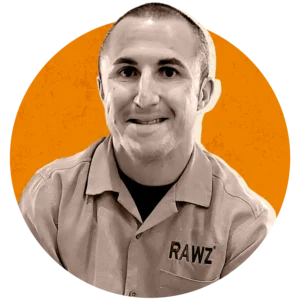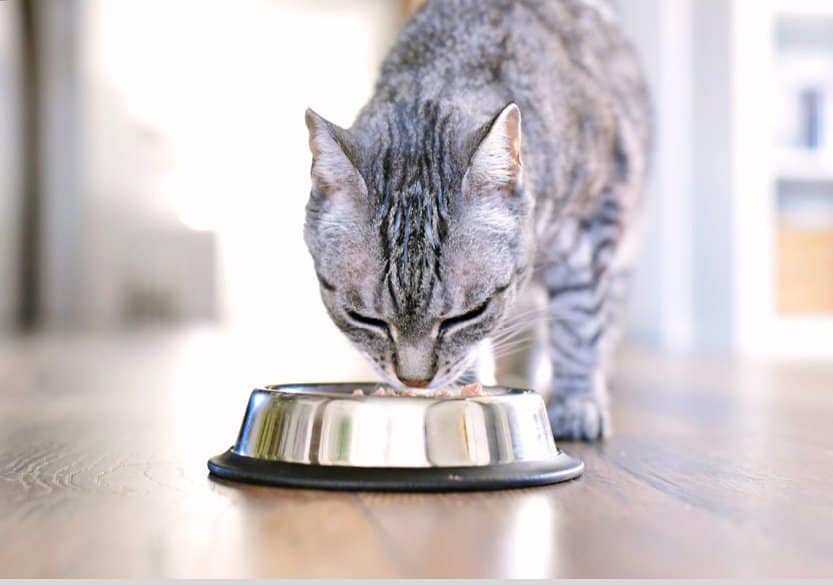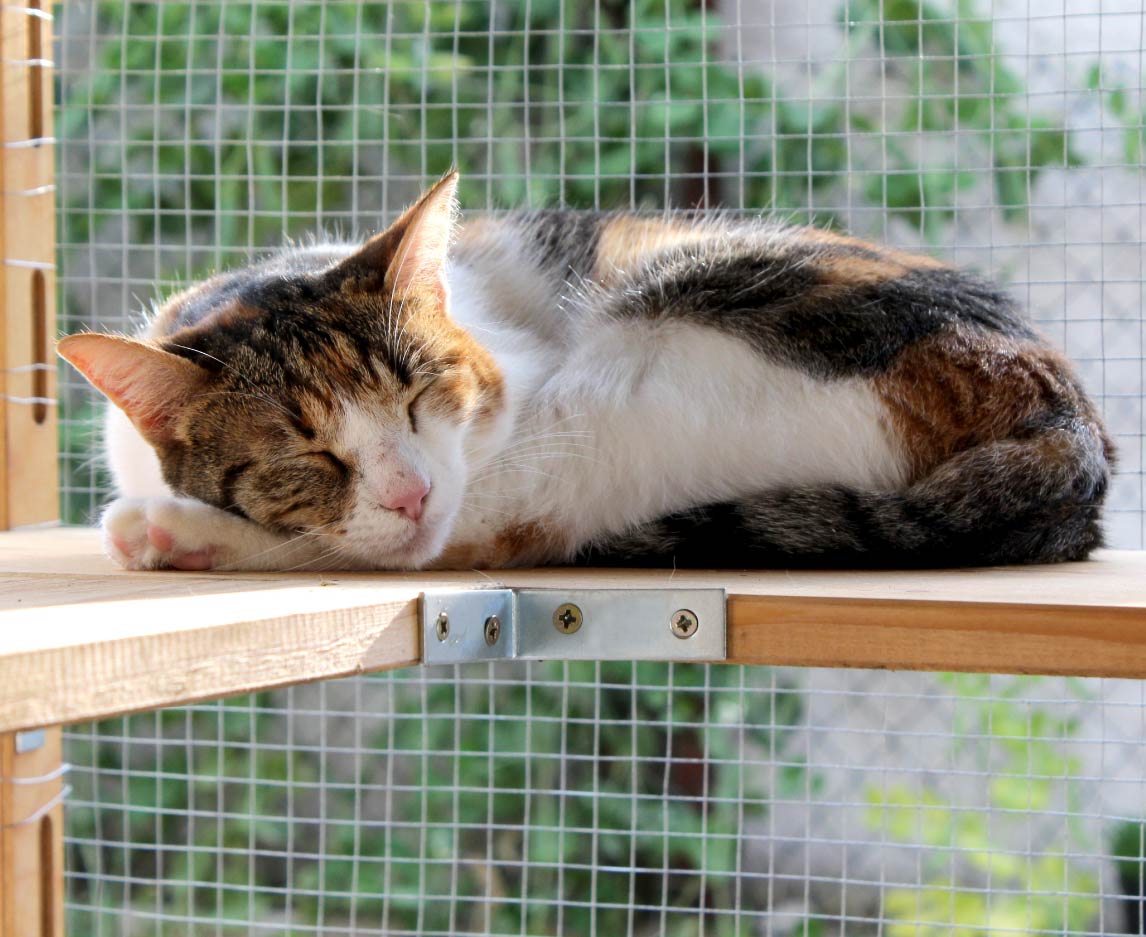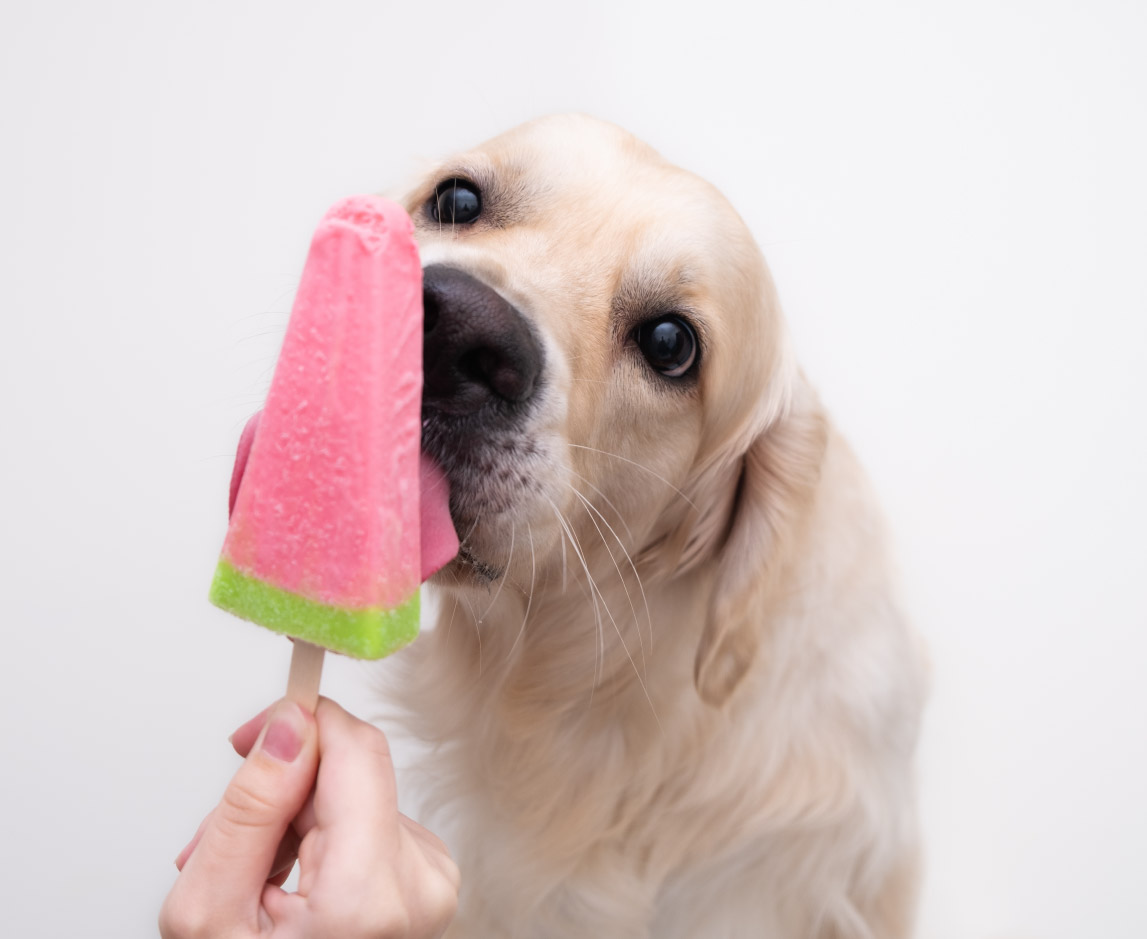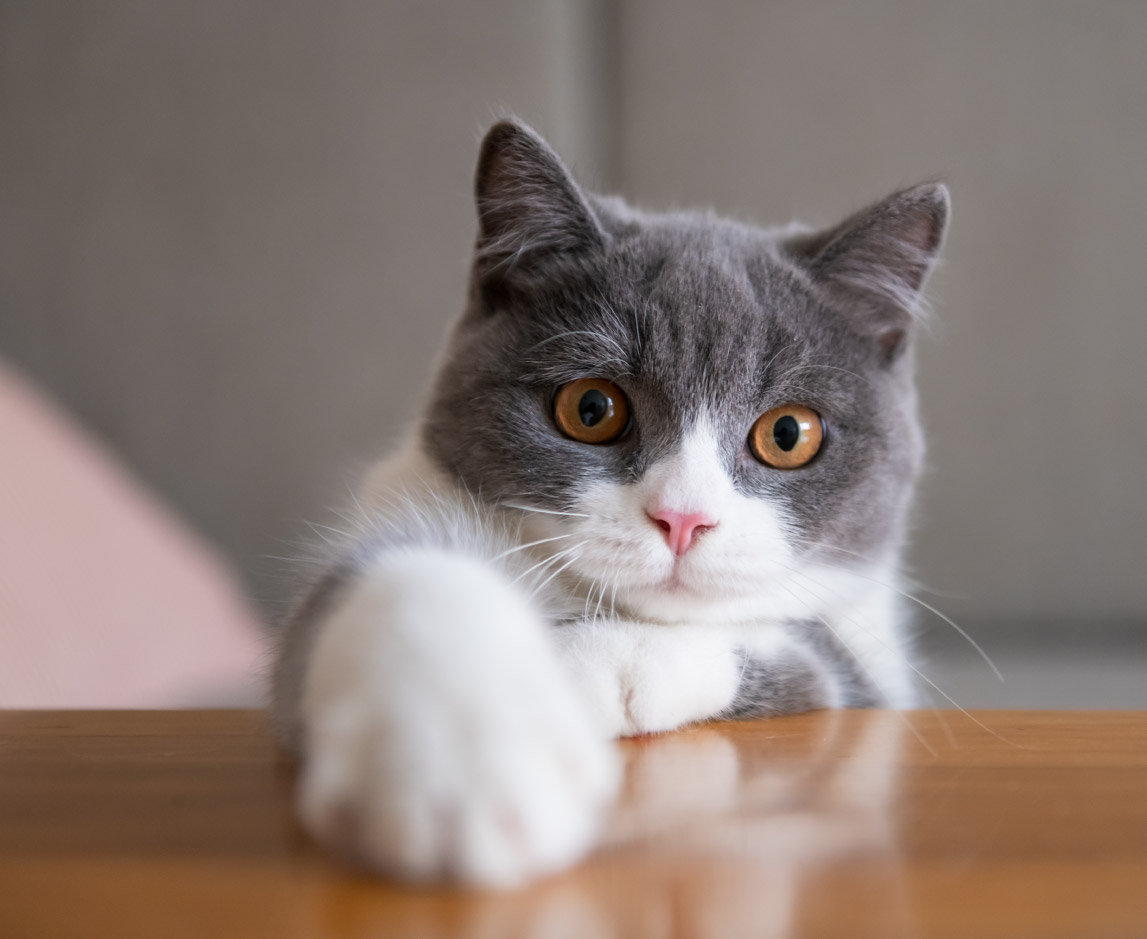How much should you feed your cat? Is half a cup of dry kibble enough? How many ounces of wet food is the right amount? Should your cat eat three times a day like humans do?
There isn’t a universal answer to any of these questions because every cat is different. The exact amount and type of food your cat needs will depend on many factors. Read on for details.
- 5 Factors That Affect How Much You Should Feed Your Cat
- When Should I Feed My Cat?
- Dry Food vs. Wet Food
- Natural Cat Feeding Behaviors
- Ideal Weight for Cats
- 5 Common Cat Feeding Mistakes
- Cat Feeding FAQs
Note: This blog post includes general information from various reputable sources. However, you should always talk to your veterinarian before changing your cat’s food or feeding schedule.
5 Factors That Affect How Much You Should Feed Your Cat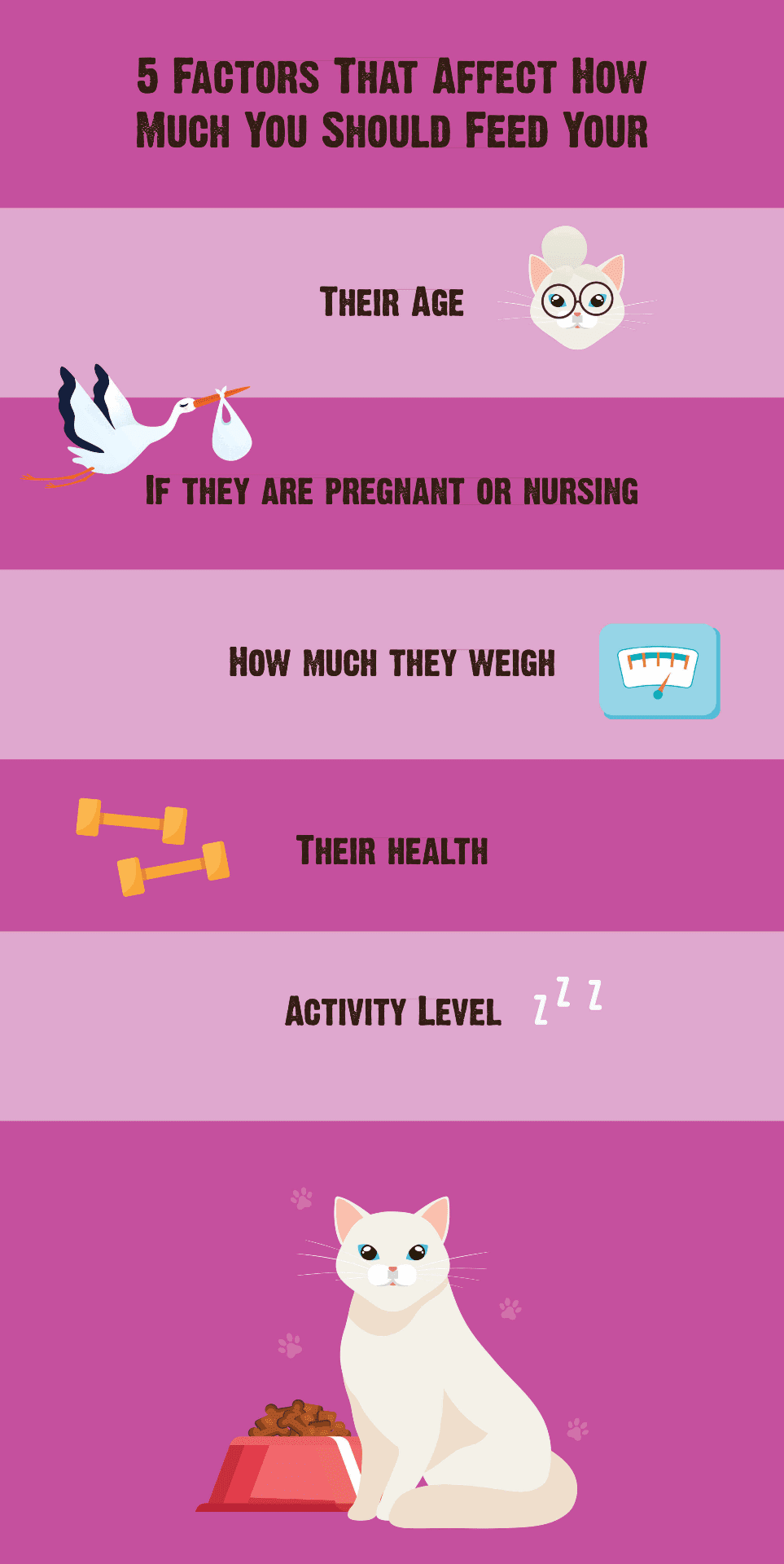
1. Their age
Francis Kallfelz, DVM, Ph.D., of Cornell University’s College of Veterinary Medicine advises that "growing kittens up to six months of age may require three meals a day.” Kittens require more food per pound of body weight than adult cats in order to get the necessary nutrients to support their growth.
For adult cats, Kallfelz says that “from age six months to maturity, most cats will do well when fed two times a day." Just make sure that the two meals aren’t too far apart. VCA Animal Hospitals notes that “if more than 12 hours elapses between meals, the stomach can become hyper acidic causing nausea.”
2. If they are pregnant or nursing
Throughout a cat’s pregnancy, PetMD says to “feed your queen the same food she has always enjoyed, but start mixing protein into the meals.”
Also keep in mind the space that the kittens are taking up inside your cat. “There will not be much room left for food, so your cat will need to eat smaller and more frequent meals,” says PetMD. “Make sure that there is always food available for when she is hungry, and, most importantly, that there is always water available to her.”
The last few weeks of pregnancy is when a cat’s appetite increases the most, and it’s when her belly will really start to show. In the late stages of pregnancy, you can switch her food to one that is formulated for growing kittens. PetMD goes on to say that “you can continue that diet while she is nursing and until she has weaned her kittens, supplementing it with a quality canned food.”
3. How much they weigh
To maintain a normal, healthy weight, Fetch by WebMD says that cats should eat between 24 to 35 calories a day, per pound. For an eight-pound cat, this would equate to 192 to 280 calories a day. To put this into perspective, a 5.5 ounce can of RAWZ turkey and turkey liver pate is 199 calories. Half of a cup of RAWZ salmon meal free dry cat food is 230 calories.
If you cat is underweight or overweight, you will need to work closely with your veterinarian to make sure you’re feeding them appropriately. Overweight cats, especially those with diabetes or other health conditions, should always receive measured food amounts. The Cummings Veterinary Medical Center at Tufts University notes that “frequent weigh-ins are recommended to promote slow, safe weight loss.”
4. Their health
There are certain health issues that can affect how much and when to feed your cat. If your cat is recovering from surgery or has an illness, they will likely have specific nutritional requirements to ensure that their bodies are able to heal or fight off infection.
Some medications might need to be given to your cat on an empty stomach or with food. This is especially important for cats with diabetes. “It’s very important that you coordinate your meals with the insulin dosing,” says Kathryn Michel, DVM, associate professor of Nutrition at the University of Pennsylvania School of Veterinary Medicine. “You need to have their meals timed with their insulin, so they’re absorbing those calories when the peak insulin is occurring, so they don’t become hypoglycemic [have low blood sugar].”
Always consult with your veterinarian if you have concerns about your cat’s health and their feeding. They will provide exact instructions based on your cat’s past and present health.
5. Activity level
Is your cat more playful than most or do they prefer a more relaxed lifestyle? Activity levels are one of the most important factors to take into account when feeding your cat, especially since obesity is the most common nutritional disease seen in cats.
Your veterinarian will be able to recommend a feeding amount and schedule that’s most appropriate for your cat. The ASPCA explains three categories of activity levels to help you determine your cat’s needs:
- Normal activity: a cat with normal activity should be fed the recommended feeding amount for maintenance based on their weight and age.
- Less Active: a cat who is mostly sedentary may require as much as 10% below the recommended maintenance feeding amount.
- Active: a highly active cat may require 20% to 40% more than the recommended maintenance feeding amount.
When Should I Feed My Cat?
Scheduled Feeding vs. Free Feeding
There are two different types of feeding routines: Scheduled feeding vs. free feeding.
Scheduled feeding is giving your cat meals at a certain time every day. “Feeding an adult cat at regular times provides the security and predictability of a routine,” Ryan Llera, BSc, DVM and Robin Downing, DVM, DAAPM, DACVSMR, CVPP, CRPP write for VCA Animal Hospitals. “Meals become a cornerstone event of the day around which other activities are added.”
Routine feeding is the best way to monitor your cat’s eating habits, and it’s recommended for multi-cat households to make sure that one cat isn’t getting all the food. The only disadvantage here is that your cat isn’t in control and may develop a habit of excessive meowing or begging around feeding times.
Free feeding is leaving out food for your cat to graze. This gives them full control of when they eat, which can help cut back on begging. However, free feeding has a few notable disadvantages. Jackie Brown of Catster explains that “wet food won’t stay fresh very long, so it’s not a successful free-feeding option. You also can’t keep track of how much they are eating, and this can lead to overweight cats.” It’s also difficult to make sure each cat is eating enough in multi-cat homes.
VCA Animal Hospitals advises that “many cats receive too many calories and because they do not get enough physical activity, grazing or free feeding is not recommended.”
Dry Food vs. Wet Food
Should you feed your cat dry kibble or canned food?
Dry Food
Catster states that “cats on dry food-only diets are slightly more prone to obesity and diabetes than cats who eat wet cat food.” This is due to two reasons. First, dry kibble often contains a high amount of carbohydrates compared to wet food. Secondly, it’s also likely to be offered as free feeding, meaning cats have constant access to kibble and can overindulge.
Dry food contains very low levels of water, which cats need from their food since they have low thirst drives. Any cat who eats dry food should also have 24/7 access to fresh water.
Wet Food
The high moisture content of wet canned food — about 78% compared to 10% in dry food — can help compensate for your cat’s low thirst drive. Freeze-dried food may have moisture contents as low as 3% to 5%.
However, it’s important to note that low-quality wet food is not better than a premium quality dry food, so make sure you’re offering your cat nutrition of the highest quality — whether dry or wet.
When in doubt, Catster offers helpful advice when considering wet food vs. dry food for your cat. “Choose a premium cat food! Ultimately, whether choosing wet cat food vs. dry cat food, it should be a premium cat food with quality ingredients. The higher initial cost will be offset long-term by reduced veterinary costs.”
Natural Feeding Behavior of Cats
Dr. Sarah Gorman, associate veterinarian at Boston Animal Hospital, explains that eating behaviors in cats are a combination of inherited and learned components. “It’s not just about what is natural for the cat to do with food, but also how that cat has been nurtured to react to feeding time,” she said.
Cats are naturally obligate carnivores, which means their diets require nutrients that are only found in meat. In the wild, cats prefer to eat alone, unless they are sharing food with their offspring. If you have multiple cats, it may be in their best interest to separate their food bowls during feeding time.
Ideal Weight for Cats
Although the recommended weight for domestic cats is about 10 pounds, this will depend on the breed. Fetch by WebMD says that “a Siamese cat may weigh as few as 5 pounds, while a Maine Coon can be 25 pounds and healthy.”
Obesity is a big concern for all breeds, as it can lead to arthritis, diabetes and urinary tract disease. Diabetes is particularly concerning — an obese cat is three times more likely to develop type 2 diabetes than a cat of normal weight, according to Fetch by WebMD. Cornell University also says that “obese cats are twice as likely to die in middle age, which for cats is six to 12 years.”
Ultimately, the ideal weight for your cat should be determined by your veterinarian.
5 Common Cat Feeding Mistakes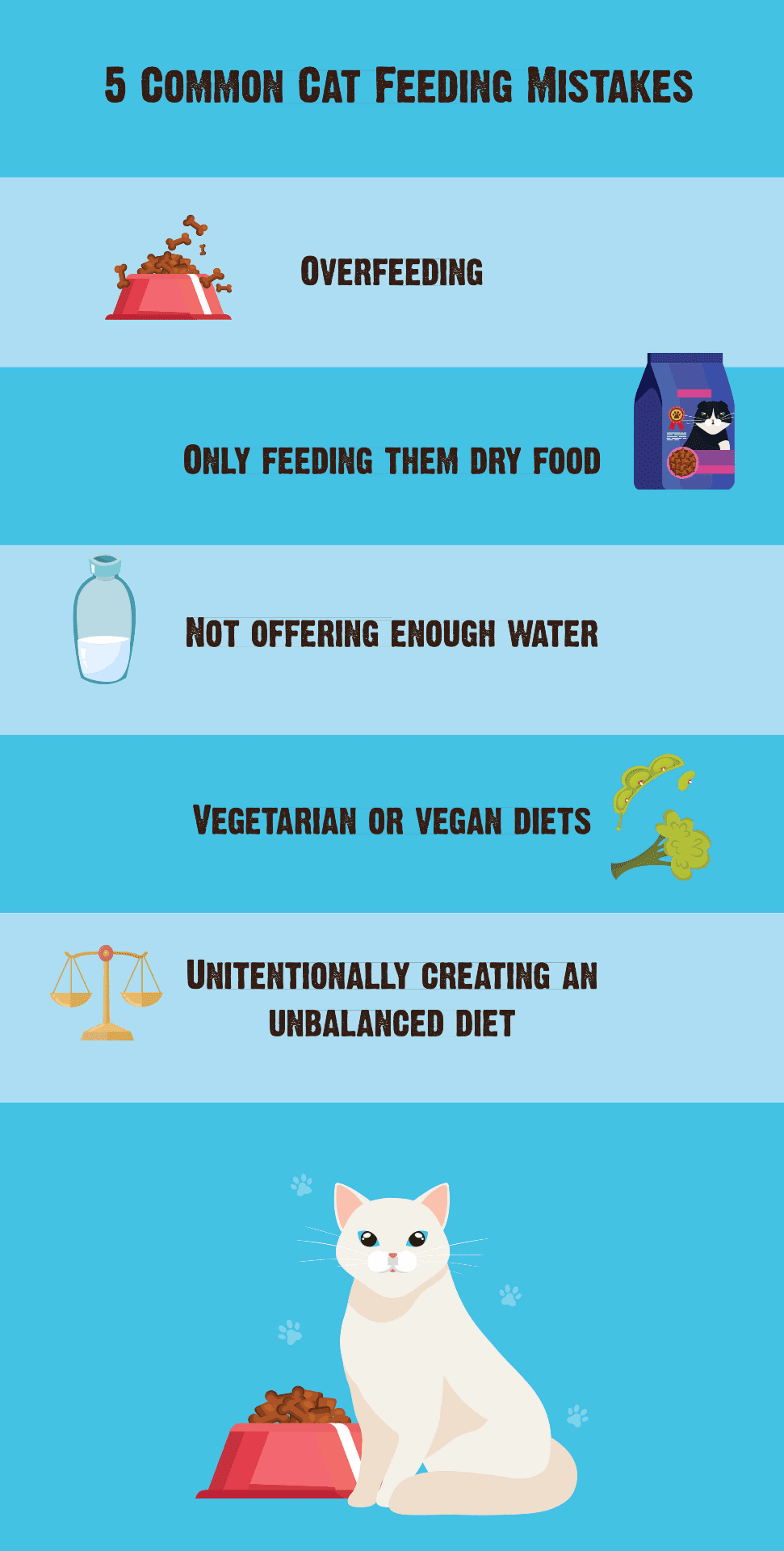
1. Overfeeding
“Probably the most common mistake people make when feeding cats is over-feeding,” says Joe Bartges, DVM, PhD, DACVIM, DACVN and professor of medicine and nutrition.
It’s easy to overfeed a cat, because their nutritional needs have changed. Cats “are more sedentary, as compared to the days when they were barn cats and more active,” says Linda P. Case, MS, author of The Cat: Its Behavior, Nutrition, and Health. “They're little couch potatoes now, their nutrition needs are much lower, so it's easy to overfeed them.”
2. Only feeding them dry food
High-quality wet food is recommended in addition to dry kibble or exclusively. Cats don’t have a natural thirst drive like dogs do, so they need to get their water from their food.
Dry food is only 10% to 12% water while canned food is 78% water. “Canned food does a much better job of keeping your cat well-hydrated,” says Lisa A. Pierson, DVM. “Think of canned food as hosing down your cat's bladder several times a day.”
3. Not offering enough water
In addition to the water in wet food, cats should have access to fresh water sources. This can be a dish of water near their food bowl or running water from an automated water station. Some cats can detect the chlorine from tap water, which they may not like. You can offer filtered or bottled water to encourage your cat to drink.
4. Vegetarian or vegan diets
As we mentioned, cats are obligate carnivores. They need a diet of mostly meat in order to get the right nutrients to keep them healthy and thriving, so a vegetarian or vegan diet isn’t recommended.
Fetch by WebMD says that “the amino acid taurine, for example, is found only in animal tissue. Lack of taurine can lead a cat to experience heart problems, blindness, and even death.”
5. Unintentionally creating an unbalanced diet
Homemade and raw food diets for cats have become popular over the years, but if not prepared properly, they can lead to nutritional deficiencies.
Pierson says that pet owners need to balance meat with the right amount of calcium. “A cat would be eating both the meat and bones of their prey, which provides a proper calcium-to-phosphorus ratio.”
On the other hand, too much of certain nutrients can cause also problems. Diets heavy in tuna, liver or liver oil can result in vitamin A toxicosis and too much raw fish can affect vitamin B1 levels. The side effects can make your cat very uncomfortable, ranging from dry skin and joint pain to more severe conditions like seizure or brain damage.
Cat Feeding Chart
Use this feeding chart to determine how much food your cat should be eating each day, based on their body size and divided across 2–3 meals. The amounts recommended here are based on the calorie content of the food.
An important note: Since cats have different health and nutritional needs, the amount of food you should be feeding them each day may vary. This table is meant as a general guide, and all amounts should be considered suggestions for how much to feed your cat based on their food’s calorie content. Please consult your veterinarian or pet nutritionist to determine your cat’s specific needs.
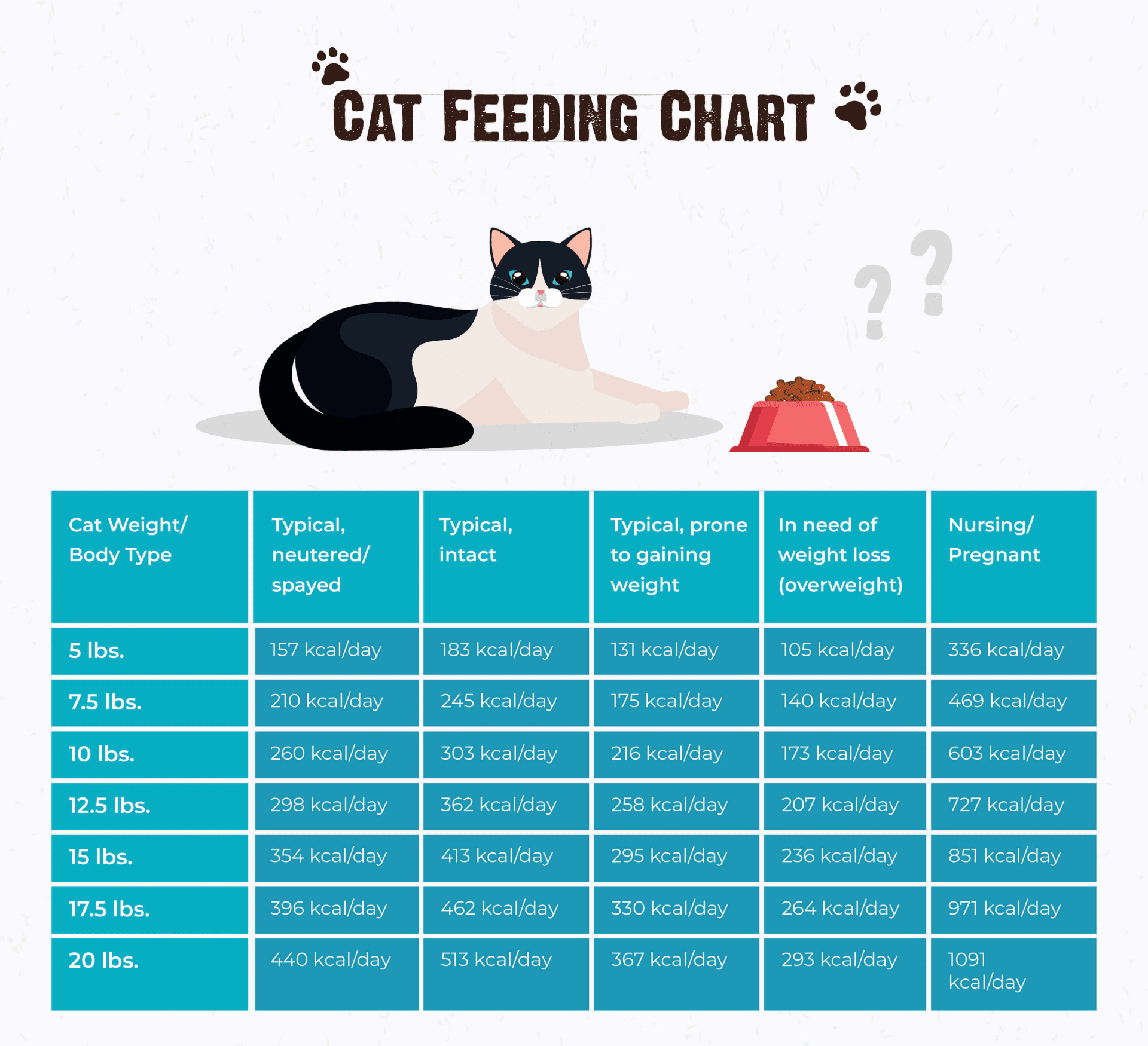
What the Vets Have to Say About It
“If we assume the average cat weighs approximately 10 pounds (5 kg) then the average indoor cat needs 250 calories a day,” according to the team at Kirkwood Animal Hospital in Kirkwood, Missouri. “Most high quality foods have approximately 500 calories per 8 ounce cup of food” — meaning an average-sized house cat should have a total of 4 ounces (½ cup) of food a day.
Knowing how much to feed your cat starts with identifying their ideal body weight. This is something you should discuss with your cat’s veterinarian, but you can do a quick visual assessment at home. “Cats should have ribs and a spine that are easy to feel but not too bony,” writes Dr. Jacqueline Brister, DVM for Embrace Pet Insurance. “When looking at a kitty from above, the abdomen (the region between the ribs and hips) should taper in somewhat.” In other words, a cat of a healthy weight should have an “hourglass” figure.
However, there are some exceptions to this “thin and trim” rule. “As cats enter adulthood, they may develop extra, loose skin on the belly region in between their legs” — a feature vets call “the primordial pouch,” according to Dr. Brister. “Veterinary experts aren’t exactly sure why cats have it, but it is likely used for protection of important belly structures during a fight.” While normal, your vet should still examine your older cat to see whether this pouch is too large for its body size.
If you are looking to make some changes in your cat’s weight (with the guidance of a vet), you can track their progress by reassessing their shape every two weeks or so following a diet change. “Once you have found the amount that maintains your cat’s ideal body condition (i.e., not too thin, not too fat), you can use monthly weigh-ins … to make small adjustments to how much you are offering to keep her right where she needs to be,” writes Dr. Jennifer Coates, DVM, for PetMD.
“Of course, what you feed is just as important as how much you feed,” she continues. For example, since cats derive much of their energy from protein instead of carbohydrates, they should be eating a protein-based diet. “Cats require taurine, an amino acid that is found only in animal based protein,” says Dr. Coates. That means feeding them minimally processed meat and cooked eggs (in moderation). However, Dr. Coates advises that “milk should not be fed to cats because cats do not produce the enzyme that breaks down the lactose in milk,” which can cause vomiting.
If you’re having trouble getting your cat interested in a new food, or aren’t seeing the desired changes despite smaller portions, try food puzzles. “Puzzle feeders [or food toys] promote both mental and physical stimulation for your cat, as they are naturally adept at hunting and searching for food,” according to Dr. Ilona Rodan, DVM, and
Julia Pinckney, MSc. for Cat Care Clinic in Madison, Wisconsin. They recommend starting with an easy food puzzle, like dividing up their dry food in an ice cube tray, and working up to more complicated ones that involve problem-solving. “Use a new one every meal, or change them out if you notice your cat losing interest in one or it has become too easy for your cat,” write Pinckney and Dr. Rodan. Food puzzles also force cats to slow down their feeding, which can help them avoid gorging. Food Puzzles for Cats offers up some great DIY ideas that can even get kids involved in pet care.
RELATED READING: WHAT'S IN THEIR BOWL? HERE'S HOW TO READ & DECODE A PET FOOD LABEL >
Cat Feeding FAQs
Q: Do cats need wet food?
A: Cathealth.com explains that “the average cat who eats only dry food needs to drink several ounces of water a day to make up for the lack of water from food.” Since cats have a limited thirst drive, they often will not drink enough water to compensate. Feeding a high-moisture wet food even just a few times a week can naturally increase their hydration levels.
Q: How should I feed multiple cats in the same household?
A: Scheduled meal times are recommended so that you can make sure that all cats are getting enough to eat. Free feeding runs the risk of one cat getting more than their fair share of food. You can place their bowls in different rooms to give them their own space and avoid any meal-related stress.
Q: What treats can I feed my cat?
A: You can feed your cat treats in moderation. Make sure that they are high-quality treats that don’t provide more than 10% of your cat's energy and calorie intake.
Q: How many calories a day does my cat need?
A: Fetch by WebMD recommends 24 to 35 calories a day per pound. If your cat is highly active or more sedentary than other cats, you may need to make adjustments to avoid under or over feeding.
RAWZ is proud to offer certified low glycemic cat food. Glycemic index measures food’s effect on an animal’s blood sugar. Similar to humans, when a cat’s blood sugar levels are too high, they can become obese — especially if they also have low activity levels. Our low glycemic wet and dry cat food options provide the nutrients cats need to stay healthy or to get back on the right track.

